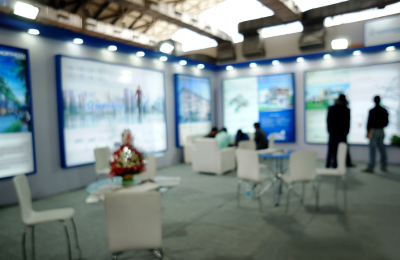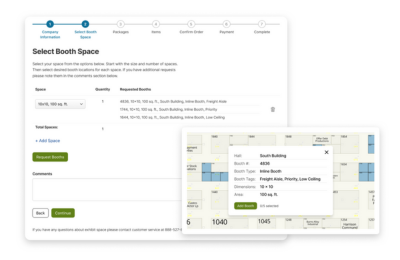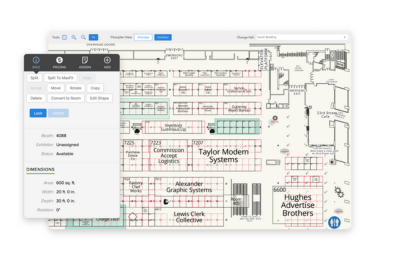Share this
Trade Show Floor Plan Recommendations for Single and Multi-Hall Shows
by Madison Frye on March 4, 2024
Organizing a successful trade show, conference, or industry event requires a balance of creativity, strategic planning, and a keen understanding of your show audience. If you want to make your event stand out, this starts with a well-crafted trade show floor plan. In this blog, we'll explore insights into creating a floor plan for both single and multi-level events. From zoning to event management technology, here are some exhibition tips on how to “wow” your audience.
Content Written by Madison Frye, Marketing Associate at Map Your Show.
Table of Contents:
- Multi-Hall Show Recommendations
- Designated Lounges and Networking Areas.
- Information Hubs and Attendee Guidance.
- Strategic Zoning.
- Themed Areas.
- Flexible Booth Space Options.
- Onsite Educational Opportunities.
- Show Sponsorship Options.
- Single-Hall Show Recommendations
- Open Concept Show Floor Layouts.
- Themed Areas or Zones.
- Utilizing Event Management Technology.
- Networking Hubs.
- Clear Signage.
- Sponsorship Integration.
- Data-Driven Optimization.
- Conclusion.
Multi-Hall Show Recommendations:
1. Designated Lounges and Networking Areas.
 Trade shows can be overwhelming, and attendees appreciate designated areas to rest and connect. By incorporating comfortable lounges and networking spaces on each level, you create an environment that encourages spontaneous and genuine networking opportunities.
Trade shows can be overwhelming, and attendees appreciate designated areas to rest and connect. By incorporating comfortable lounges and networking spaces on each level, you create an environment that encourages spontaneous and genuine networking opportunities.
2. Information Hubs and Attendee Guidance.
Navigating a multi-level trade show can be challenging for attendees without guidance. After all, exhibitors can’t gain a potential lead if the attendee is lost at the show. While there are many ways to help attendees get to where they need to go on the show floor, it starts by utilizing trade show technology to make a well-detailed event map, making show floor exploration easier than ever.
3. Strategic Zoning.
When it comes to multi-level trade shows, strategic zoning is key. Creating dedicated zones on each level can seamlessly group exhibitors based on your industry’s categories.  New Updates from Map Your Show’s Floor Builder can allow exhibitors to list their industry competitors and partners, allowing show management teams to create zones on the trade show floor with ease. This not only simplifies navigation for attendees but also eases expectations on show management teams when sifting through hundreds of exhibitor applications.
New Updates from Map Your Show’s Floor Builder can allow exhibitors to list their industry competitors and partners, allowing show management teams to create zones on the trade show floor with ease. This not only simplifies navigation for attendees but also eases expectations on show management teams when sifting through hundreds of exhibitor applications.
4. Themed Areas.
In addition to strategic zoning tactics, you can take it a step further by adding a theme to these areas. Adding a bit more excitement to each level by designating specific themes or experience opportunities (aka: “you-had-to-be-there” moments). Align these themes with the industry sectors or topics represented on each level and watch as your trade show becomes a multi-dimensional experience for attendees.
5. Flexible Booth Space Options.
Modular booth designs are by far the most popular for exhibitors to use. These can adapt to different floor layouts, but it is important to offer the correct amount of space each exhibitor may need. For shows selling by space, exhibitors can now request their booth spaces when submitting their application to exhibit. Check out more insights here to provide your exhibitors as they prepare for the upcoming industry event or trade show.
6. Onsite Educational Opportunities.
 Trade shows are so much more than just a place to sell or purchase a product. Incorporating education into your show floor is vital for the success of the industry! While dedicated areas for seminars, workshops, and product demonstrations are vital, don’t forget to utilize the trade show floor as a space for these as well. Ensure that you schedule sessions strategically to minimize congestion and encourage a natural flow between educational and exhibit spaces.
Trade shows are so much more than just a place to sell or purchase a product. Incorporating education into your show floor is vital for the success of the industry! While dedicated areas for seminars, workshops, and product demonstrations are vital, don’t forget to utilize the trade show floor as a space for these as well. Ensure that you schedule sessions strategically to minimize congestion and encourage a natural flow between educational and exhibit spaces.
7. Show Sponsorship Options.
Show sponsorships are key for your show’s bottom line and ensuring that your event’s budget can stretch further, especially in our current economy. Sponsorships also act as an opportunity to make your exhibitors shine on the show floor. While there are many ways to use them, we recommend utilizing:
- Sponsored Waiting or Rest Areas
- Sponsored Trade Show Totes
- Lounge Sponsorships
- Stage/Room Sponsorships
For more ideas on how to incorporate innovative sponsorship ideas into your trade show, read more.
Single-Hall Show Recommendations:
1. Open Concept Show Floor Layouts.
Small doesn't have to mean cramped. Opt for an open-concept floor plan to create an airy and inviting atmosphere. This not only enhances the overall experience of your audience but also smooths traffic flow through the space available.
2. Themed Areas or Zones.
Similar to multi-hall shows, single-hall shows can also benefit from themed areas across their show. Enhance the appeal of your trade show by creating themed areas or zones within the limited space. This adds variety and keeps attendees engaged as they navigate through different sections, providing a curated experience no matter the scale.
3. Utilizing Event Management Technology.
Trade show technology can make a big impact on show management teams while they are planning and executing a trade show. It’s more important than ever to make a lasting impression and ensure that attendees and exhibitors alike are gaining a big “value add” by attending the show, no matter the size. With event management technology, you can create this experience, while providing ease to your team.  New to Map Your Show’s Builder, exhibitors can list their competitors and partners when requesting a booth. This allows your team to make an educated decision on booth spaces, without having to research it on your own. On top of this, Map Your Show’s event management technology offers the ability to create a floor plan with or without a CAD file, a “Max Fit” filter to help guide you when creating your show floor, and so much more. You can learn more about these offerings here.
New to Map Your Show’s Builder, exhibitors can list their competitors and partners when requesting a booth. This allows your team to make an educated decision on booth spaces, without having to research it on your own. On top of this, Map Your Show’s event management technology offers the ability to create a floor plan with or without a CAD file, a “Max Fit” filter to help guide you when creating your show floor, and so much more. You can learn more about these offerings here.
4. Networking Hubs.
With smaller shows, offering more chances to create genuine networking opportunities is key.  Your show management team can do this by creating designated areas as networking hubs or lounges to foster connections in your show space. These hubs can serve as meeting points, encouraging spontaneous interactions, and also provide a break from the bustling trade show floor. Something unique to a smaller show is that networking at the event becomes more relaxed and genuine. Breaking the ice at a session and on the show floor tends to happen quicker than a large show.
Your show management team can do this by creating designated areas as networking hubs or lounges to foster connections in your show space. These hubs can serve as meeting points, encouraging spontaneous interactions, and also provide a break from the bustling trade show floor. Something unique to a smaller show is that networking at the event becomes more relaxed and genuine. Breaking the ice at a session and on the show floor tends to happen quicker than a large show.
5. Clear Signage.
While your trade show may not be as large as others, that does not eliminate the need for trade show signage to guide the attendees throughout the show. In fact, clear signage is paramount. Ensure that directional signs are prominently placed, guiding attendees to different sections and exhibitors. This will minimize confusion and maximize the time attendees spend engaging with exhibitors.
6. Sponsorship Integration.
Offer creative sponsorship opportunities that integrate seamlessly into the small floor plan. One unique option would be arrows on the show floor, leading to a sponsored exhibitor. From branded lounges to sponsored charging stations, strategically place sponsorship elements across the show floor to maximize the visibility of your exhibitors and enhance the overall ambiance.
For more ideas on how to incorporate innovative sponsorship ideas into your trade show, read more.
7. Data-Driven Optimization.
To make sure that attendees have the best possible experience at a trade show, it's important to keep track of how they're moving around and interacting with the space.  By analyzing this data, organizers can tweak the floor plan and improve the layout for future events. This will help to keep attendees engaged and happy, while ultimately leading to greater success for everyone involved.
By analyzing this data, organizers can tweak the floor plan and improve the layout for future events. This will help to keep attendees engaged and happy, while ultimately leading to greater success for everyone involved.
For Map Your Show customers, you can request a Post Show Report from your sales representative to further review data from your show.
Conclusion
Trade shows and industry events are an essential part of business growth and development. These events bring together industry professionals, thought leaders, and decision-makers to network and discover the latest trends and innovations in the field. To create a successful event, organizers need to put in a lot of effort, creativity, and strategic planning. One of the key elements of event planning is creating a well-crafted trade show floor plan.
Whether it's a single-hall show or a multi-level trade show, there are several important factors to consider when creating a trade show floor plan. For multi-level events, designated lounges and networking areas can provide attendees with the much-needed space to rest and connect with other professionals.
For single-hall shows, opting for an open-concept floor plan can create an inviting atmosphere, and incorporating themed areas or zones can provide attendees with a curated experience. Utilizing event management technology can help show management teams plan and execute the event with ease while increasing the value added for attendees and exhibitors.
For any questions or comments, please contact our team at www.mapyourshow.com or the form below.
Contact Us
Share this
- Best Practices (35)
- News (33)
- Insider (27)
- Trade Show Managers (27)
- Newsletter (20)
- exhibitors (14)
- Event Mobile App (7)
- Guide (7)
- Interview (7)
- Case Study (6)
- Conference Management (5)
- Event Recap (5)
- AI (3)
- Booth Sales (3)
- Customers (3)
- MYS Team (2)
- Sales Accelerator (1)
- Trade Show Sponsorship (1)
- December 2025 (4)
- November 2025 (2)
- October 2025 (3)
- September 2025 (2)
- August 2025 (2)
- July 2025 (3)
- June 2025 (2)
- May 2025 (2)
- April 2025 (2)
- March 2025 (3)
- February 2025 (2)
- January 2025 (3)
- December 2024 (2)
- November 2024 (1)
- October 2024 (3)
- September 2024 (4)
- August 2024 (3)
- July 2024 (8)
- June 2024 (4)
- May 2024 (6)
- March 2024 (7)
- February 2024 (2)
- January 2024 (4)
- December 2023 (1)
- November 2023 (3)
- October 2023 (3)
- September 2023 (3)
- August 2023 (1)
- July 2023 (3)
- June 2023 (2)
- May 2023 (3)
- February 2023 (1)
- January 2023 (1)
- August 2022 (1)
- March 2022 (1)
- January 2022 (1)
- October 2021 (1)
- September 2021 (1)